Health Research Priority Setting Report: Data Comparison and Analysis
VerifiedAdded on 2021/05/31
|11
|2758
|29
Report
AI Summary
This report analyzes a health research priority setting exercise, focusing on data extracted from various sources, including age, gender, and socioeconomic factors. It compares data related to obesity, psychological distress, and the prevalence of diseases like hypertension and diabetes, highlighting the impact of socioeconomic inequalities on health outcomes. The report also examines social determinants of health, assessing the number of people affected, the impact of health problems, and government priorities. Furthermore, it discusses the availability of resources for problem-solving, the economic cost of not addressing health issues, and the potential for positive change. The analysis includes data from Crownlands, a small agricultural community, illustrating the relationship between health indicators and demographic factors. The report emphasizes the importance of primary health mechanisms and addressing upstream determinants such as housing, education, employment, and transport to achieve significant and lasting improvements in public health.
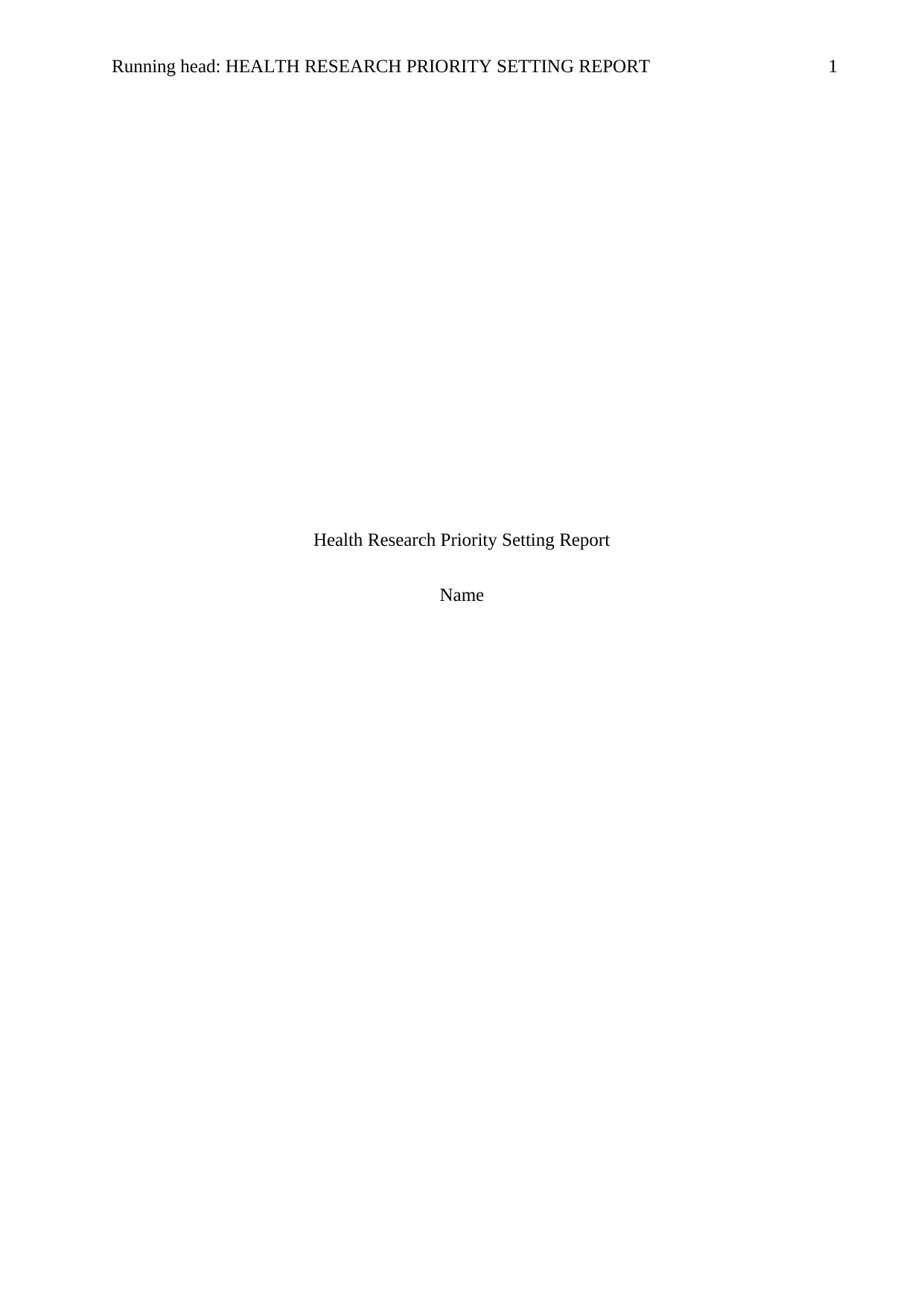
Running head: HEALTH RESEARCH PRIORITY SETTING REPORT 1
Health Research Priority Setting Report
Name
Health Research Priority Setting Report
Name
Paraphrase This Document
Need a fresh take? Get an instant paraphrase of this document with our AI Paraphraser
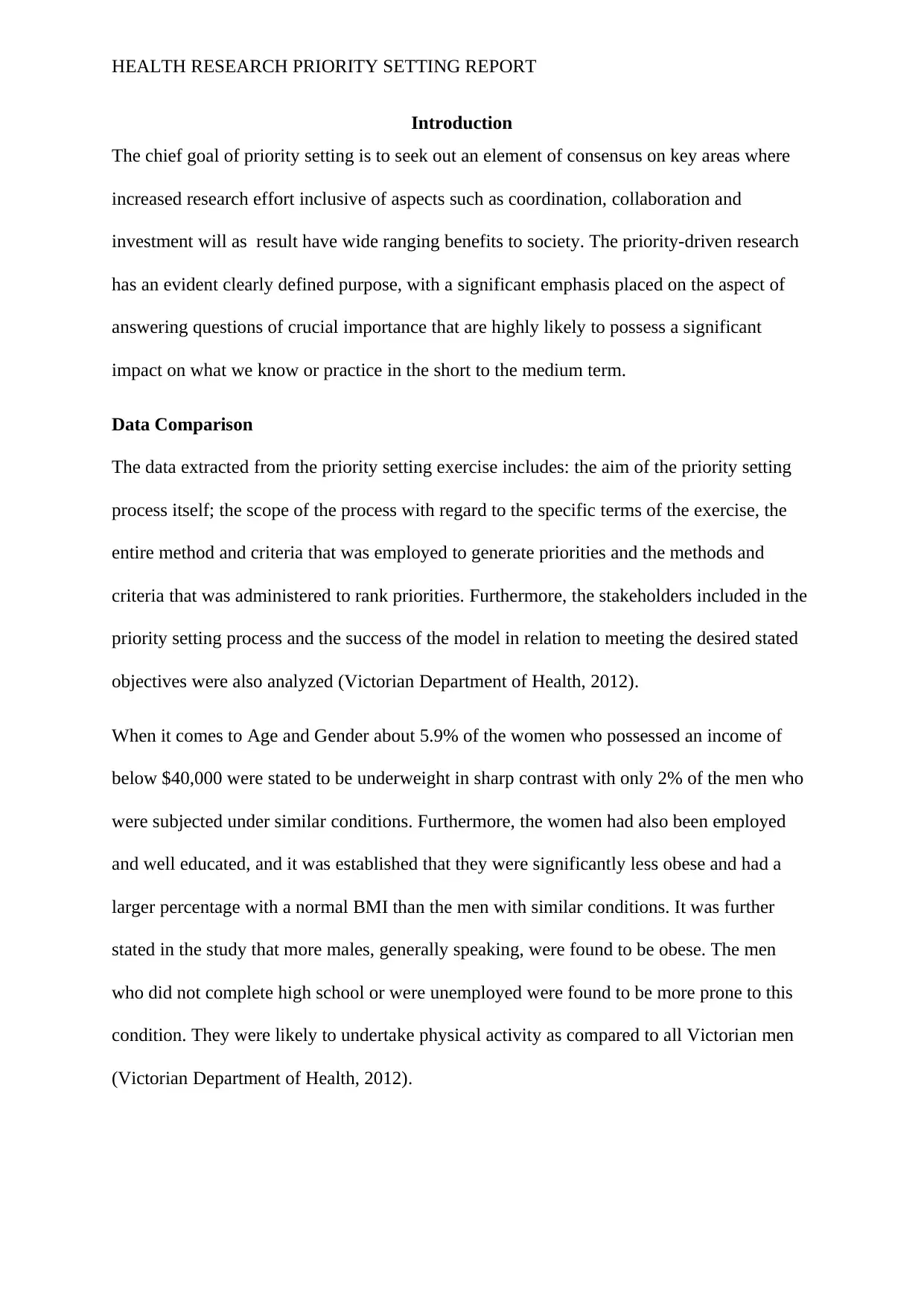
HEALTH RESEARCH PRIORITY SETTING REPORT
Introduction
The chief goal of priority setting is to seek out an element of consensus on key areas where
increased research effort inclusive of aspects such as coordination, collaboration and
investment will as result have wide ranging benefits to society. The priority-driven research
has an evident clearly defined purpose, with a significant emphasis placed on the aspect of
answering questions of crucial importance that are highly likely to possess a significant
impact on what we know or practice in the short to the medium term.
Data Comparison
The data extracted from the priority setting exercise includes: the aim of the priority setting
process itself; the scope of the process with regard to the specific terms of the exercise, the
entire method and criteria that was employed to generate priorities and the methods and
criteria that was administered to rank priorities. Furthermore, the stakeholders included in the
priority setting process and the success of the model in relation to meeting the desired stated
objectives were also analyzed (Victorian Department of Health, 2012).
When it comes to Age and Gender about 5.9% of the women who possessed an income of
below $40,000 were stated to be underweight in sharp contrast with only 2% of the men who
were subjected under similar conditions. Furthermore, the women had also been employed
and well educated, and it was established that they were significantly less obese and had a
larger percentage with a normal BMI than the men with similar conditions. It was further
stated in the study that more males, generally speaking, were found to be obese. The men
who did not complete high school or were unemployed were found to be more prone to this
condition. They were likely to undertake physical activity as compared to all Victorian men
(Victorian Department of Health, 2012).
Introduction
The chief goal of priority setting is to seek out an element of consensus on key areas where
increased research effort inclusive of aspects such as coordination, collaboration and
investment will as result have wide ranging benefits to society. The priority-driven research
has an evident clearly defined purpose, with a significant emphasis placed on the aspect of
answering questions of crucial importance that are highly likely to possess a significant
impact on what we know or practice in the short to the medium term.
Data Comparison
The data extracted from the priority setting exercise includes: the aim of the priority setting
process itself; the scope of the process with regard to the specific terms of the exercise, the
entire method and criteria that was employed to generate priorities and the methods and
criteria that was administered to rank priorities. Furthermore, the stakeholders included in the
priority setting process and the success of the model in relation to meeting the desired stated
objectives were also analyzed (Victorian Department of Health, 2012).
When it comes to Age and Gender about 5.9% of the women who possessed an income of
below $40,000 were stated to be underweight in sharp contrast with only 2% of the men who
were subjected under similar conditions. Furthermore, the women had also been employed
and well educated, and it was established that they were significantly less obese and had a
larger percentage with a normal BMI than the men with similar conditions. It was further
stated in the study that more males, generally speaking, were found to be obese. The men
who did not complete high school or were unemployed were found to be more prone to this
condition. They were likely to undertake physical activity as compared to all Victorian men
(Victorian Department of Health, 2012).
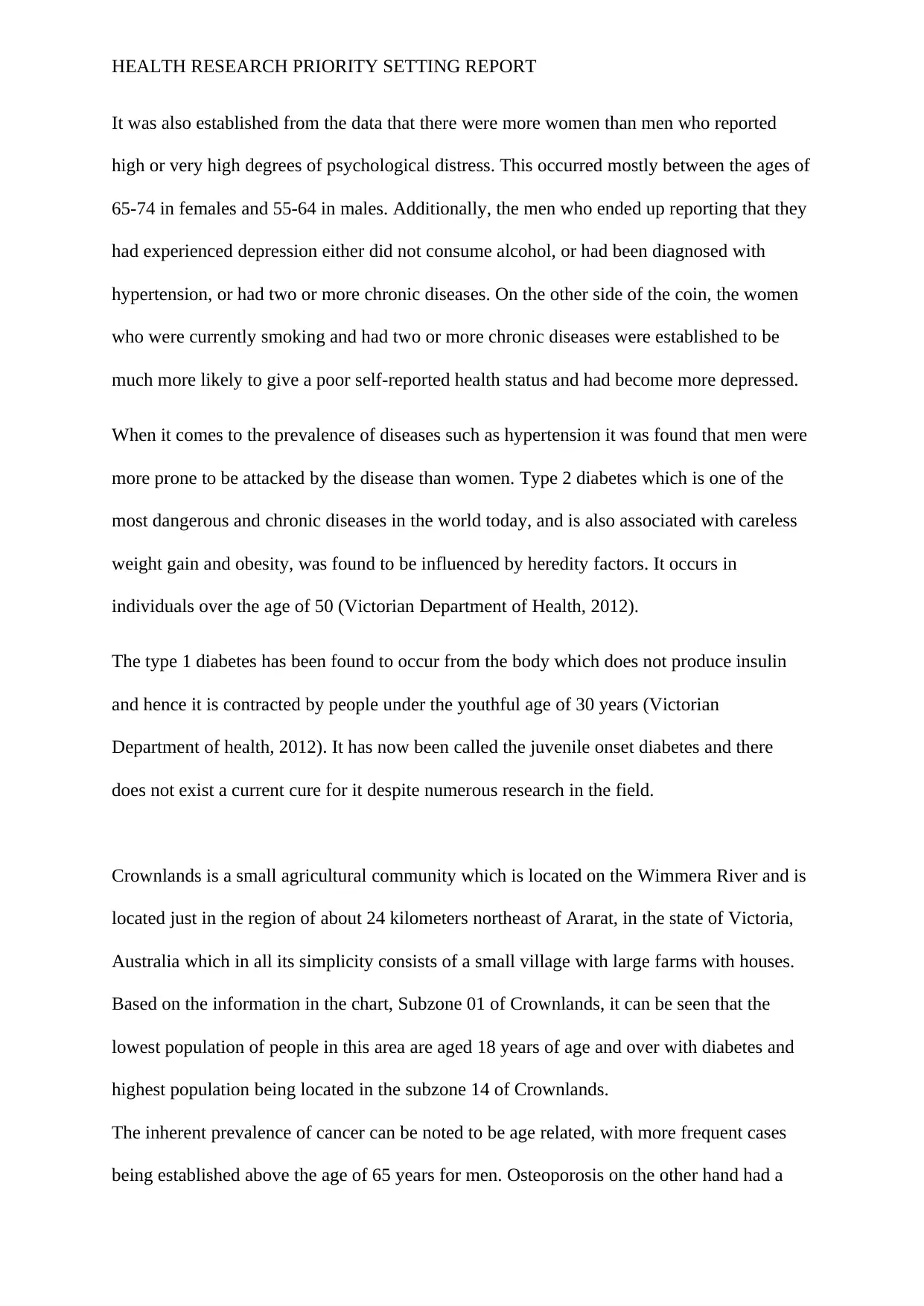
HEALTH RESEARCH PRIORITY SETTING REPORT
It was also established from the data that there were more women than men who reported
high or very high degrees of psychological distress. This occurred mostly between the ages of
65-74 in females and 55-64 in males. Additionally, the men who ended up reporting that they
had experienced depression either did not consume alcohol, or had been diagnosed with
hypertension, or had two or more chronic diseases. On the other side of the coin, the women
who were currently smoking and had two or more chronic diseases were established to be
much more likely to give a poor self-reported health status and had become more depressed.
When it comes to the prevalence of diseases such as hypertension it was found that men were
more prone to be attacked by the disease than women. Type 2 diabetes which is one of the
most dangerous and chronic diseases in the world today, and is also associated with careless
weight gain and obesity, was found to be influenced by heredity factors. It occurs in
individuals over the age of 50 (Victorian Department of Health, 2012).
The type 1 diabetes has been found to occur from the body which does not produce insulin
and hence it is contracted by people under the youthful age of 30 years (Victorian
Department of health, 2012). It has now been called the juvenile onset diabetes and there
does not exist a current cure for it despite numerous research in the field.
Crownlands is a small agricultural community which is located on the Wimmera River and is
located just in the region of about 24 kilometers northeast of Ararat, in the state of Victoria,
Australia which in all its simplicity consists of a small village with large farms with houses.
Based on the information in the chart, Subzone 01 of Crownlands, it can be seen that the
lowest population of people in this area are aged 18 years of age and over with diabetes and
highest population being located in the subzone 14 of Crownlands.
The inherent prevalence of cancer can be noted to be age related, with more frequent cases
being established above the age of 65 years for men. Osteoporosis on the other hand had a
It was also established from the data that there were more women than men who reported
high or very high degrees of psychological distress. This occurred mostly between the ages of
65-74 in females and 55-64 in males. Additionally, the men who ended up reporting that they
had experienced depression either did not consume alcohol, or had been diagnosed with
hypertension, or had two or more chronic diseases. On the other side of the coin, the women
who were currently smoking and had two or more chronic diseases were established to be
much more likely to give a poor self-reported health status and had become more depressed.
When it comes to the prevalence of diseases such as hypertension it was found that men were
more prone to be attacked by the disease than women. Type 2 diabetes which is one of the
most dangerous and chronic diseases in the world today, and is also associated with careless
weight gain and obesity, was found to be influenced by heredity factors. It occurs in
individuals over the age of 50 (Victorian Department of Health, 2012).
The type 1 diabetes has been found to occur from the body which does not produce insulin
and hence it is contracted by people under the youthful age of 30 years (Victorian
Department of health, 2012). It has now been called the juvenile onset diabetes and there
does not exist a current cure for it despite numerous research in the field.
Crownlands is a small agricultural community which is located on the Wimmera River and is
located just in the region of about 24 kilometers northeast of Ararat, in the state of Victoria,
Australia which in all its simplicity consists of a small village with large farms with houses.
Based on the information in the chart, Subzone 01 of Crownlands, it can be seen that the
lowest population of people in this area are aged 18 years of age and over with diabetes and
highest population being located in the subzone 14 of Crownlands.
The inherent prevalence of cancer can be noted to be age related, with more frequent cases
being established above the age of 65 years for men. Osteoporosis on the other hand had a
⊘ This is a preview!⊘
Do you want full access?
Subscribe today to unlock all pages.

Trusted by 1+ million students worldwide
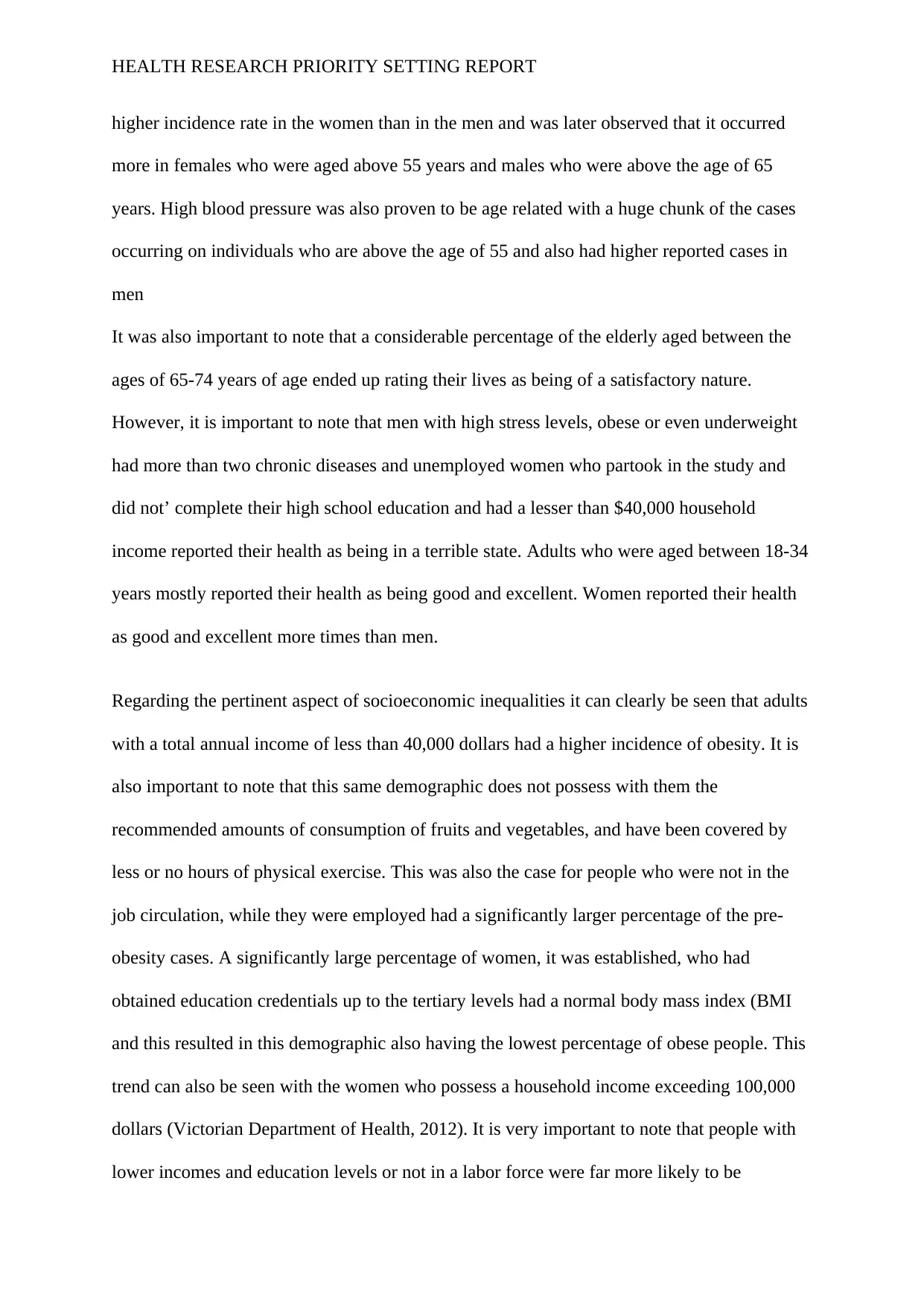
HEALTH RESEARCH PRIORITY SETTING REPORT
higher incidence rate in the women than in the men and was later observed that it occurred
more in females who were aged above 55 years and males who were above the age of 65
years. High blood pressure was also proven to be age related with a huge chunk of the cases
occurring on individuals who are above the age of 55 and also had higher reported cases in
men
It was also important to note that a considerable percentage of the elderly aged between the
ages of 65-74 years of age ended up rating their lives as being of a satisfactory nature.
However, it is important to note that men with high stress levels, obese or even underweight
had more than two chronic diseases and unemployed women who partook in the study and
did not’ complete their high school education and had a lesser than $40,000 household
income reported their health as being in a terrible state. Adults who were aged between 18-34
years mostly reported their health as being good and excellent. Women reported their health
as good and excellent more times than men.
Regarding the pertinent aspect of socioeconomic inequalities it can clearly be seen that adults
with a total annual income of less than 40,000 dollars had a higher incidence of obesity. It is
also important to note that this same demographic does not possess with them the
recommended amounts of consumption of fruits and vegetables, and have been covered by
less or no hours of physical exercise. This was also the case for people who were not in the
job circulation, while they were employed had a significantly larger percentage of the pre-
obesity cases. A significantly large percentage of women, it was established, who had
obtained education credentials up to the tertiary levels had a normal body mass index (BMI
and this resulted in this demographic also having the lowest percentage of obese people. This
trend can also be seen with the women who possess a household income exceeding 100,000
dollars (Victorian Department of Health, 2012). It is very important to note that people with
lower incomes and education levels or not in a labor force were far more likely to be
higher incidence rate in the women than in the men and was later observed that it occurred
more in females who were aged above 55 years and males who were above the age of 65
years. High blood pressure was also proven to be age related with a huge chunk of the cases
occurring on individuals who are above the age of 55 and also had higher reported cases in
men
It was also important to note that a considerable percentage of the elderly aged between the
ages of 65-74 years of age ended up rating their lives as being of a satisfactory nature.
However, it is important to note that men with high stress levels, obese or even underweight
had more than two chronic diseases and unemployed women who partook in the study and
did not’ complete their high school education and had a lesser than $40,000 household
income reported their health as being in a terrible state. Adults who were aged between 18-34
years mostly reported their health as being good and excellent. Women reported their health
as good and excellent more times than men.
Regarding the pertinent aspect of socioeconomic inequalities it can clearly be seen that adults
with a total annual income of less than 40,000 dollars had a higher incidence of obesity. It is
also important to note that this same demographic does not possess with them the
recommended amounts of consumption of fruits and vegetables, and have been covered by
less or no hours of physical exercise. This was also the case for people who were not in the
job circulation, while they were employed had a significantly larger percentage of the pre-
obesity cases. A significantly large percentage of women, it was established, who had
obtained education credentials up to the tertiary levels had a normal body mass index (BMI
and this resulted in this demographic also having the lowest percentage of obese people. This
trend can also be seen with the women who possess a household income exceeding 100,000
dollars (Victorian Department of Health, 2012). It is very important to note that people with
lower incomes and education levels or not in a labor force were far more likely to be
Paraphrase This Document
Need a fresh take? Get an instant paraphrase of this document with our AI Paraphraser
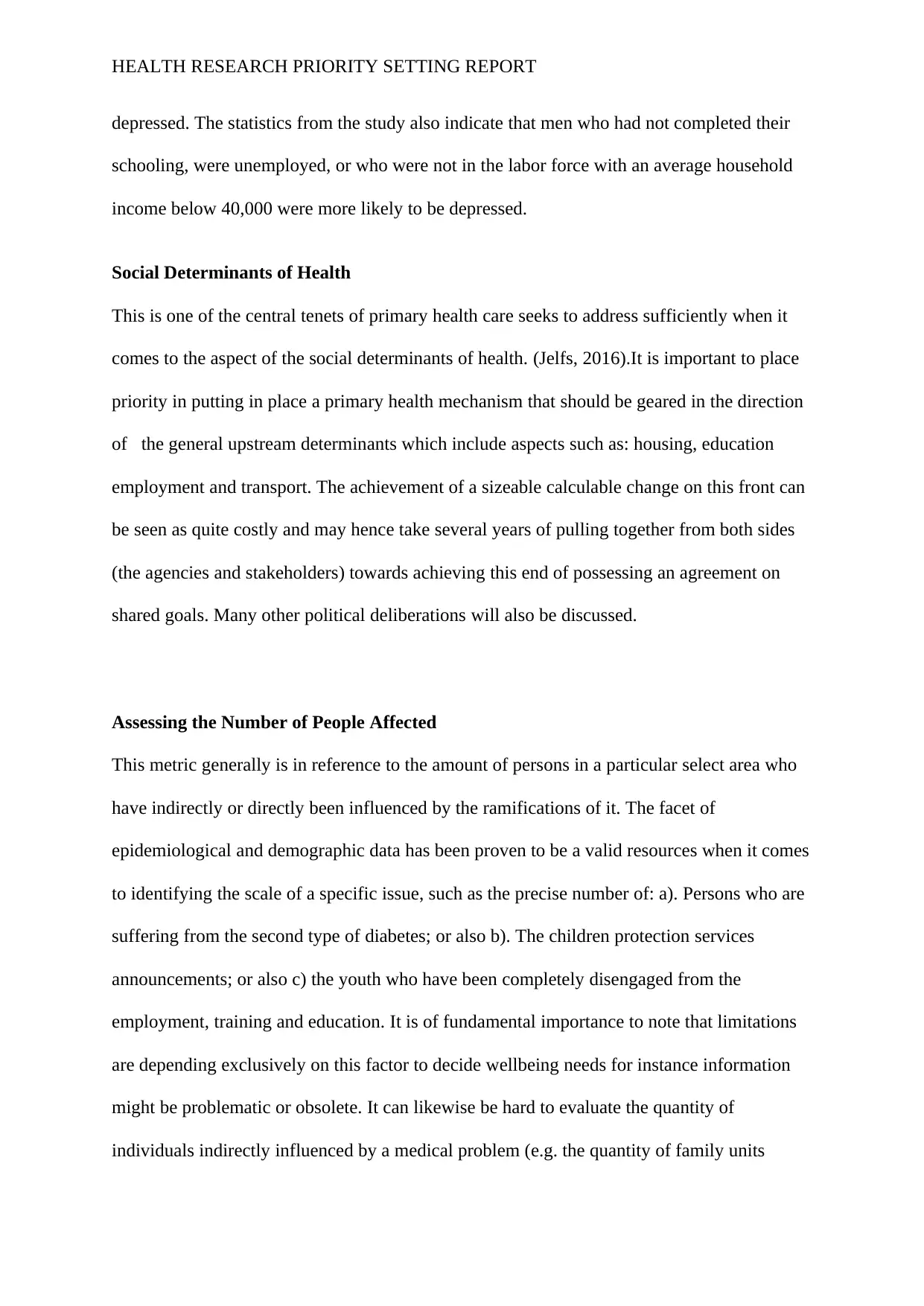
HEALTH RESEARCH PRIORITY SETTING REPORT
depressed. The statistics from the study also indicate that men who had not completed their
schooling, were unemployed, or who were not in the labor force with an average household
income below 40,000 were more likely to be depressed.
Social Determinants of Health
This is one of the central tenets of primary health care seeks to address sufficiently when it
comes to the aspect of the social determinants of health. (Jelfs, 2016).It is important to place
priority in putting in place a primary health mechanism that should be geared in the direction
of the general upstream determinants which include aspects such as: housing, education
employment and transport. The achievement of a sizeable calculable change on this front can
be seen as quite costly and may hence take several years of pulling together from both sides
(the agencies and stakeholders) towards achieving this end of possessing an agreement on
shared goals. Many other political deliberations will also be discussed.
Assessing the Number of People Affected
This metric generally is in reference to the amount of persons in a particular select area who
have indirectly or directly been influenced by the ramifications of it. The facet of
epidemiological and demographic data has been proven to be a valid resources when it comes
to identifying the scale of a specific issue, such as the precise number of: a). Persons who are
suffering from the second type of diabetes; or also b). The children protection services
announcements; or also c) the youth who have been completely disengaged from the
employment, training and education. It is of fundamental importance to note that limitations
are depending exclusively on this factor to decide wellbeing needs for instance information
might be problematic or obsolete. It can likewise be hard to evaluate the quantity of
individuals indirectly influenced by a medical problem (e.g. the quantity of family units
depressed. The statistics from the study also indicate that men who had not completed their
schooling, were unemployed, or who were not in the labor force with an average household
income below 40,000 were more likely to be depressed.
Social Determinants of Health
This is one of the central tenets of primary health care seeks to address sufficiently when it
comes to the aspect of the social determinants of health. (Jelfs, 2016).It is important to place
priority in putting in place a primary health mechanism that should be geared in the direction
of the general upstream determinants which include aspects such as: housing, education
employment and transport. The achievement of a sizeable calculable change on this front can
be seen as quite costly and may hence take several years of pulling together from both sides
(the agencies and stakeholders) towards achieving this end of possessing an agreement on
shared goals. Many other political deliberations will also be discussed.
Assessing the Number of People Affected
This metric generally is in reference to the amount of persons in a particular select area who
have indirectly or directly been influenced by the ramifications of it. The facet of
epidemiological and demographic data has been proven to be a valid resources when it comes
to identifying the scale of a specific issue, such as the precise number of: a). Persons who are
suffering from the second type of diabetes; or also b). The children protection services
announcements; or also c) the youth who have been completely disengaged from the
employment, training and education. It is of fundamental importance to note that limitations
are depending exclusively on this factor to decide wellbeing needs for instance information
might be problematic or obsolete. It can likewise be hard to evaluate the quantity of
individuals indirectly influenced by a medical problem (e.g. the quantity of family units
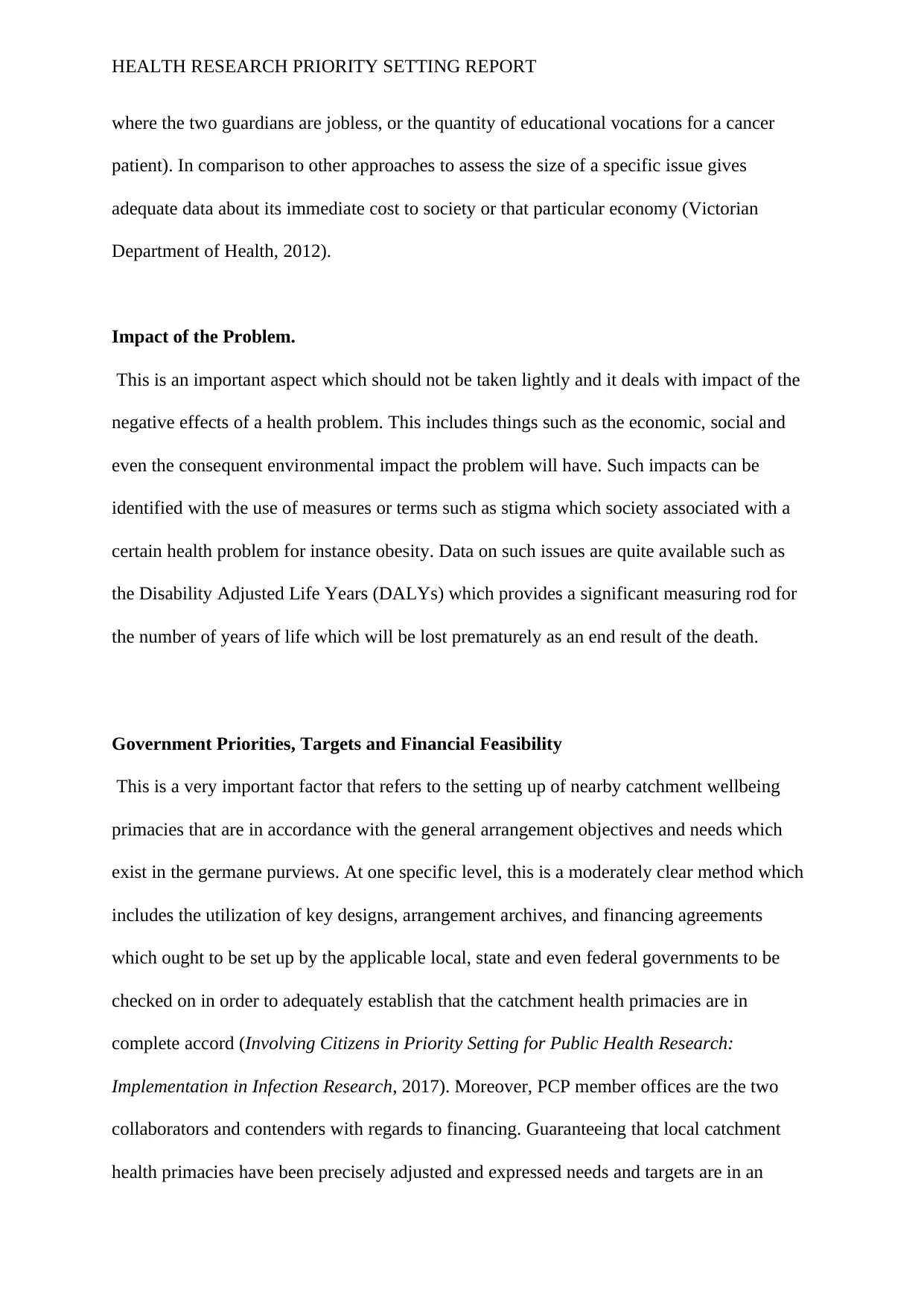
HEALTH RESEARCH PRIORITY SETTING REPORT
where the two guardians are jobless, or the quantity of educational vocations for a cancer
patient). In comparison to other approaches to assess the size of a specific issue gives
adequate data about its immediate cost to society or that particular economy (Victorian
Department of Health, 2012).
Impact of the Problem.
This is an important aspect which should not be taken lightly and it deals with impact of the
negative effects of a health problem. This includes things such as the economic, social and
even the consequent environmental impact the problem will have. Such impacts can be
identified with the use of measures or terms such as stigma which society associated with a
certain health problem for instance obesity. Data on such issues are quite available such as
the Disability Adjusted Life Years (DALYs) which provides a significant measuring rod for
the number of years of life which will be lost prematurely as an end result of the death.
Government Priorities, Targets and Financial Feasibility
This is a very important factor that refers to the setting up of nearby catchment wellbeing
primacies that are in accordance with the general arrangement objectives and needs which
exist in the germane purviews. At one specific level, this is a moderately clear method which
includes the utilization of key designs, arrangement archives, and financing agreements
which ought to be set up by the applicable local, state and even federal governments to be
checked on in order to adequately establish that the catchment health primacies are in
complete accord (Involving Citizens in Priority Setting for Public Health Research:
Implementation in Infection Research, 2017). Moreover, PCP member offices are the two
collaborators and contenders with regards to financing. Guaranteeing that local catchment
health primacies have been precisely adjusted and expressed needs and targets are in an
where the two guardians are jobless, or the quantity of educational vocations for a cancer
patient). In comparison to other approaches to assess the size of a specific issue gives
adequate data about its immediate cost to society or that particular economy (Victorian
Department of Health, 2012).
Impact of the Problem.
This is an important aspect which should not be taken lightly and it deals with impact of the
negative effects of a health problem. This includes things such as the economic, social and
even the consequent environmental impact the problem will have. Such impacts can be
identified with the use of measures or terms such as stigma which society associated with a
certain health problem for instance obesity. Data on such issues are quite available such as
the Disability Adjusted Life Years (DALYs) which provides a significant measuring rod for
the number of years of life which will be lost prematurely as an end result of the death.
Government Priorities, Targets and Financial Feasibility
This is a very important factor that refers to the setting up of nearby catchment wellbeing
primacies that are in accordance with the general arrangement objectives and needs which
exist in the germane purviews. At one specific level, this is a moderately clear method which
includes the utilization of key designs, arrangement archives, and financing agreements
which ought to be set up by the applicable local, state and even federal governments to be
checked on in order to adequately establish that the catchment health primacies are in
complete accord (Involving Citizens in Priority Setting for Public Health Research:
Implementation in Infection Research, 2017). Moreover, PCP member offices are the two
collaborators and contenders with regards to financing. Guaranteeing that local catchment
health primacies have been precisely adjusted and expressed needs and targets are in an
⊘ This is a preview!⊘
Do you want full access?
Subscribe today to unlock all pages.

Trusted by 1+ million students worldwide
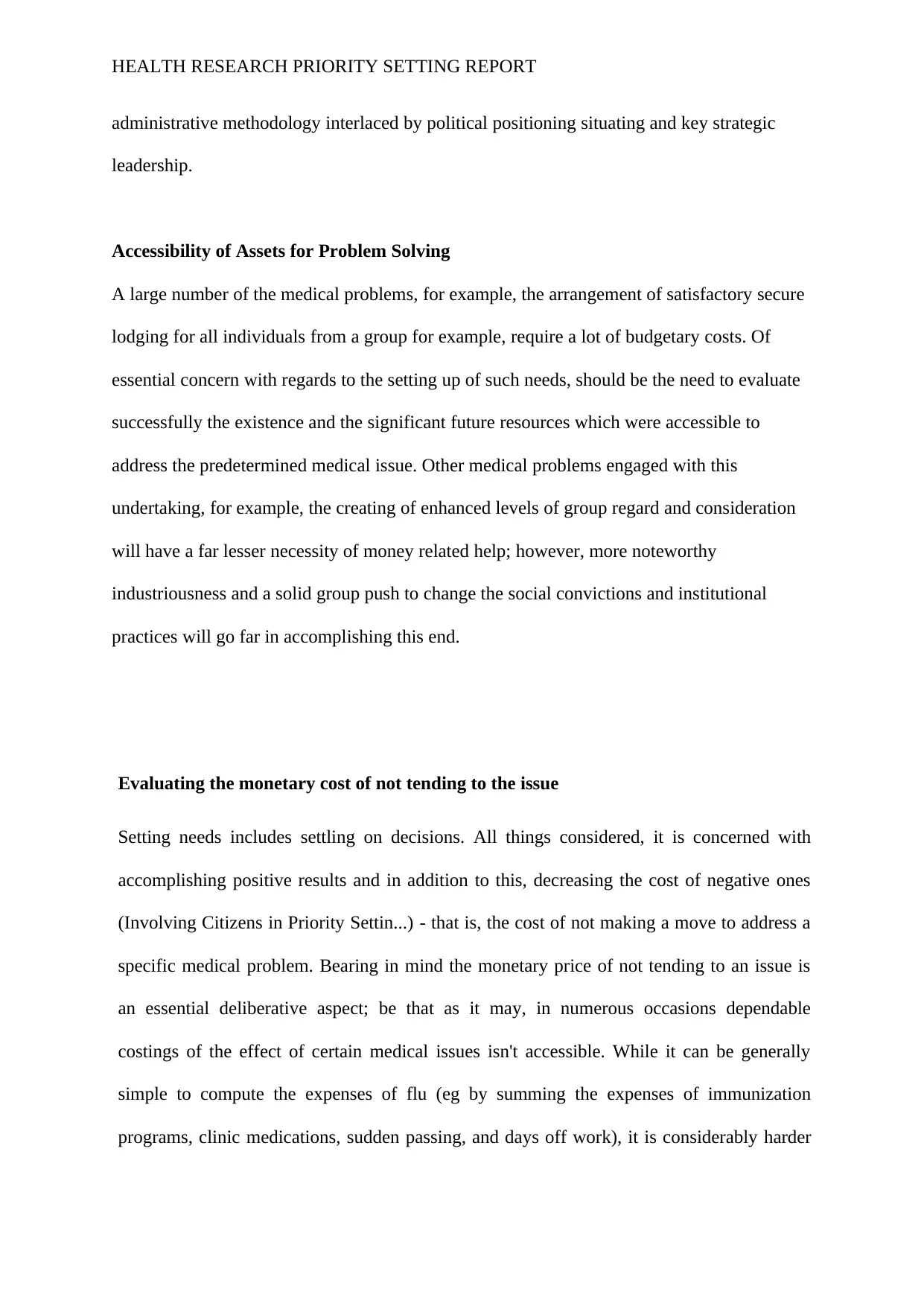
HEALTH RESEARCH PRIORITY SETTING REPORT
administrative methodology interlaced by political positioning situating and key strategic
leadership.
Accessibility of Assets for Problem Solving
A large number of the medical problems, for example, the arrangement of satisfactory secure
lodging for all individuals from a group for example, require a lot of budgetary costs. Of
essential concern with regards to the setting up of such needs, should be the need to evaluate
successfully the existence and the significant future resources which were accessible to
address the predetermined medical issue. Other medical problems engaged with this
undertaking, for example, the creating of enhanced levels of group regard and consideration
will have a far lesser necessity of money related help; however, more noteworthy
industriousness and a solid group push to change the social convictions and institutional
practices will go far in accomplishing this end.
Evaluating the monetary cost of not tending to the issue
Setting needs includes settling on decisions. All things considered, it is concerned with
accomplishing positive results and in addition to this, decreasing the cost of negative ones
(Involving Citizens in Priority Settin...) - that is, the cost of not making a move to address a
specific medical problem. Bearing in mind the monetary price of not tending to an issue is
an essential deliberative aspect; be that as it may, in numerous occasions dependable
costings of the effect of certain medical issues isn't accessible. While it can be generally
simple to compute the expenses of flu (eg by summing the expenses of immunization
programs, clinic medications, sudden passing, and days off work), it is considerably harder
administrative methodology interlaced by political positioning situating and key strategic
leadership.
Accessibility of Assets for Problem Solving
A large number of the medical problems, for example, the arrangement of satisfactory secure
lodging for all individuals from a group for example, require a lot of budgetary costs. Of
essential concern with regards to the setting up of such needs, should be the need to evaluate
successfully the existence and the significant future resources which were accessible to
address the predetermined medical issue. Other medical problems engaged with this
undertaking, for example, the creating of enhanced levels of group regard and consideration
will have a far lesser necessity of money related help; however, more noteworthy
industriousness and a solid group push to change the social convictions and institutional
practices will go far in accomplishing this end.
Evaluating the monetary cost of not tending to the issue
Setting needs includes settling on decisions. All things considered, it is concerned with
accomplishing positive results and in addition to this, decreasing the cost of negative ones
(Involving Citizens in Priority Settin...) - that is, the cost of not making a move to address a
specific medical problem. Bearing in mind the monetary price of not tending to an issue is
an essential deliberative aspect; be that as it may, in numerous occasions dependable
costings of the effect of certain medical issues isn't accessible. While it can be generally
simple to compute the expenses of flu (eg by summing the expenses of immunization
programs, clinic medications, sudden passing, and days off work), it is considerably harder
Paraphrase This Document
Need a fresh take? Get an instant paraphrase of this document with our AI Paraphraser
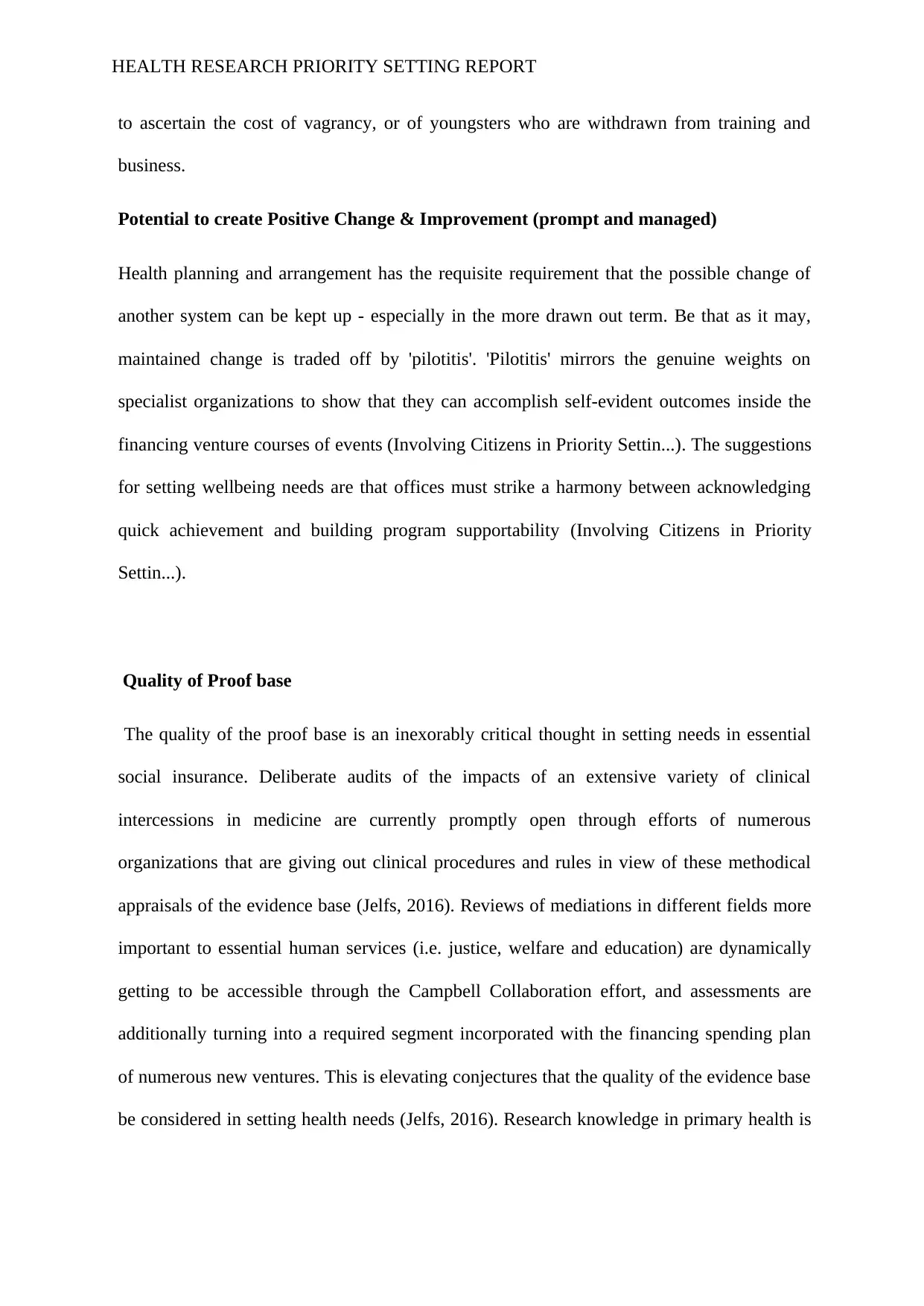
HEALTH RESEARCH PRIORITY SETTING REPORT
to ascertain the cost of vagrancy, or of youngsters who are withdrawn from training and
business.
Potential to create Positive Change & Improvement (prompt and managed)
Health planning and arrangement has the requisite requirement that the possible change of
another system can be kept up - especially in the more drawn out term. Be that as it may,
maintained change is traded off by 'pilotitis'. 'Pilotitis' mirrors the genuine weights on
specialist organizations to show that they can accomplish self-evident outcomes inside the
financing venture courses of events (Involving Citizens in Priority Settin...). The suggestions
for setting wellbeing needs are that offices must strike a harmony between acknowledging
quick achievement and building program supportability (Involving Citizens in Priority
Settin...).
Quality of Proof base
The quality of the proof base is an inexorably critical thought in setting needs in essential
social insurance. Deliberate audits of the impacts of an extensive variety of clinical
intercessions in medicine are currently promptly open through efforts of numerous
organizations that are giving out clinical procedures and rules in view of these methodical
appraisals of the evidence base (Jelfs, 2016). Reviews of mediations in different fields more
important to essential human services (i.e. justice, welfare and education) are dynamically
getting to be accessible through the Campbell Collaboration effort, and assessments are
additionally turning into a required segment incorporated with the financing spending plan
of numerous new ventures. This is elevating conjectures that the quality of the evidence base
be considered in setting health needs (Jelfs, 2016). Research knowledge in primary health is
to ascertain the cost of vagrancy, or of youngsters who are withdrawn from training and
business.
Potential to create Positive Change & Improvement (prompt and managed)
Health planning and arrangement has the requisite requirement that the possible change of
another system can be kept up - especially in the more drawn out term. Be that as it may,
maintained change is traded off by 'pilotitis'. 'Pilotitis' mirrors the genuine weights on
specialist organizations to show that they can accomplish self-evident outcomes inside the
financing venture courses of events (Involving Citizens in Priority Settin...). The suggestions
for setting wellbeing needs are that offices must strike a harmony between acknowledging
quick achievement and building program supportability (Involving Citizens in Priority
Settin...).
Quality of Proof base
The quality of the proof base is an inexorably critical thought in setting needs in essential
social insurance. Deliberate audits of the impacts of an extensive variety of clinical
intercessions in medicine are currently promptly open through efforts of numerous
organizations that are giving out clinical procedures and rules in view of these methodical
appraisals of the evidence base (Jelfs, 2016). Reviews of mediations in different fields more
important to essential human services (i.e. justice, welfare and education) are dynamically
getting to be accessible through the Campbell Collaboration effort, and assessments are
additionally turning into a required segment incorporated with the financing spending plan
of numerous new ventures. This is elevating conjectures that the quality of the evidence base
be considered in setting health needs (Jelfs, 2016). Research knowledge in primary health is
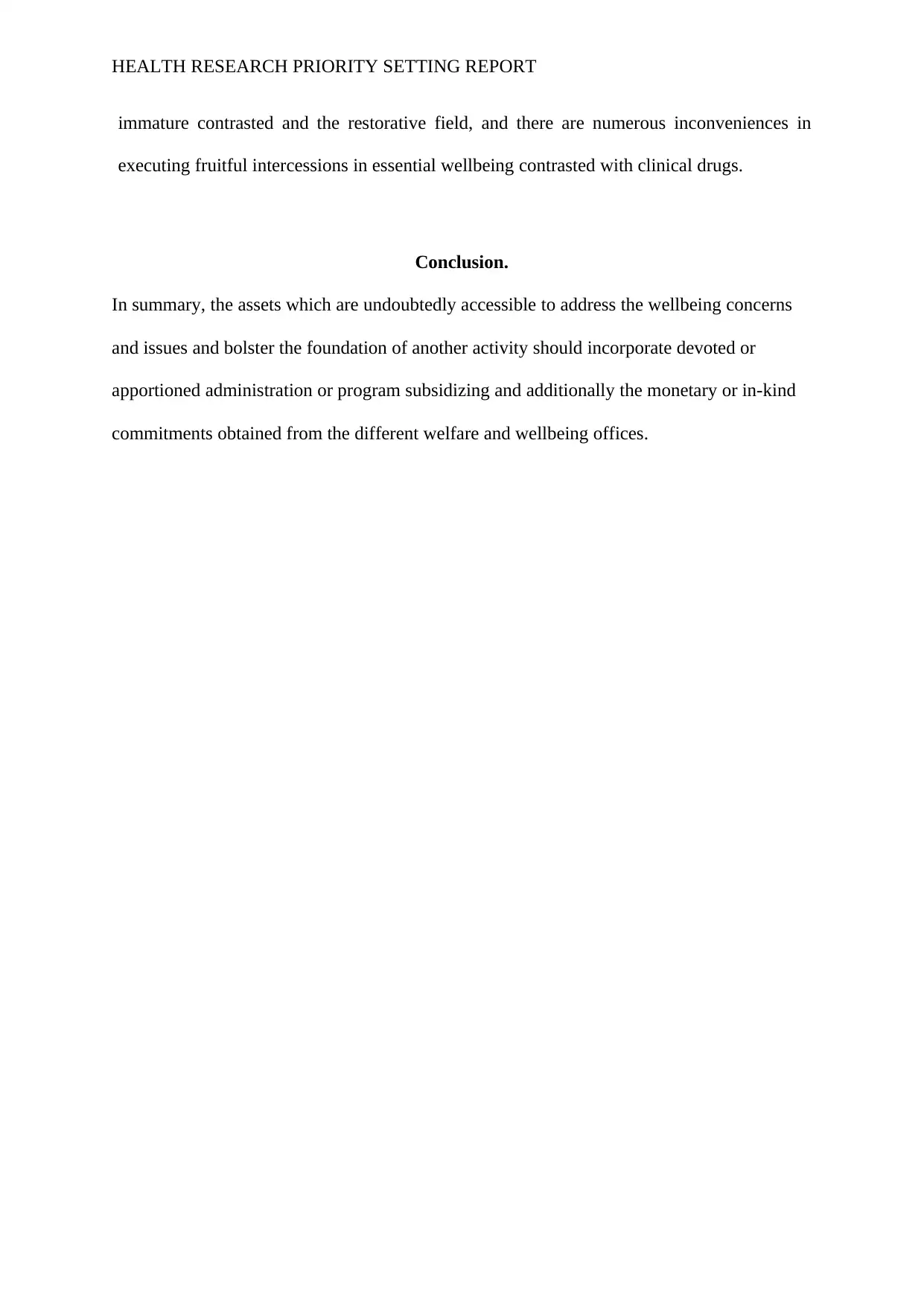
HEALTH RESEARCH PRIORITY SETTING REPORT
immature contrasted and the restorative field, and there are numerous inconveniences in
executing fruitful intercessions in essential wellbeing contrasted with clinical drugs.
Conclusion.
In summary, the assets which are undoubtedly accessible to address the wellbeing concerns
and issues and bolster the foundation of another activity should incorporate devoted or
apportioned administration or program subsidizing and additionally the monetary or in-kind
commitments obtained from the different welfare and wellbeing offices.
immature contrasted and the restorative field, and there are numerous inconveniences in
executing fruitful intercessions in essential wellbeing contrasted with clinical drugs.
Conclusion.
In summary, the assets which are undoubtedly accessible to address the wellbeing concerns
and issues and bolster the foundation of another activity should incorporate devoted or
apportioned administration or program subsidizing and additionally the monetary or in-kind
commitments obtained from the different welfare and wellbeing offices.
⊘ This is a preview!⊘
Do you want full access?
Subscribe today to unlock all pages.

Trusted by 1+ million students worldwide
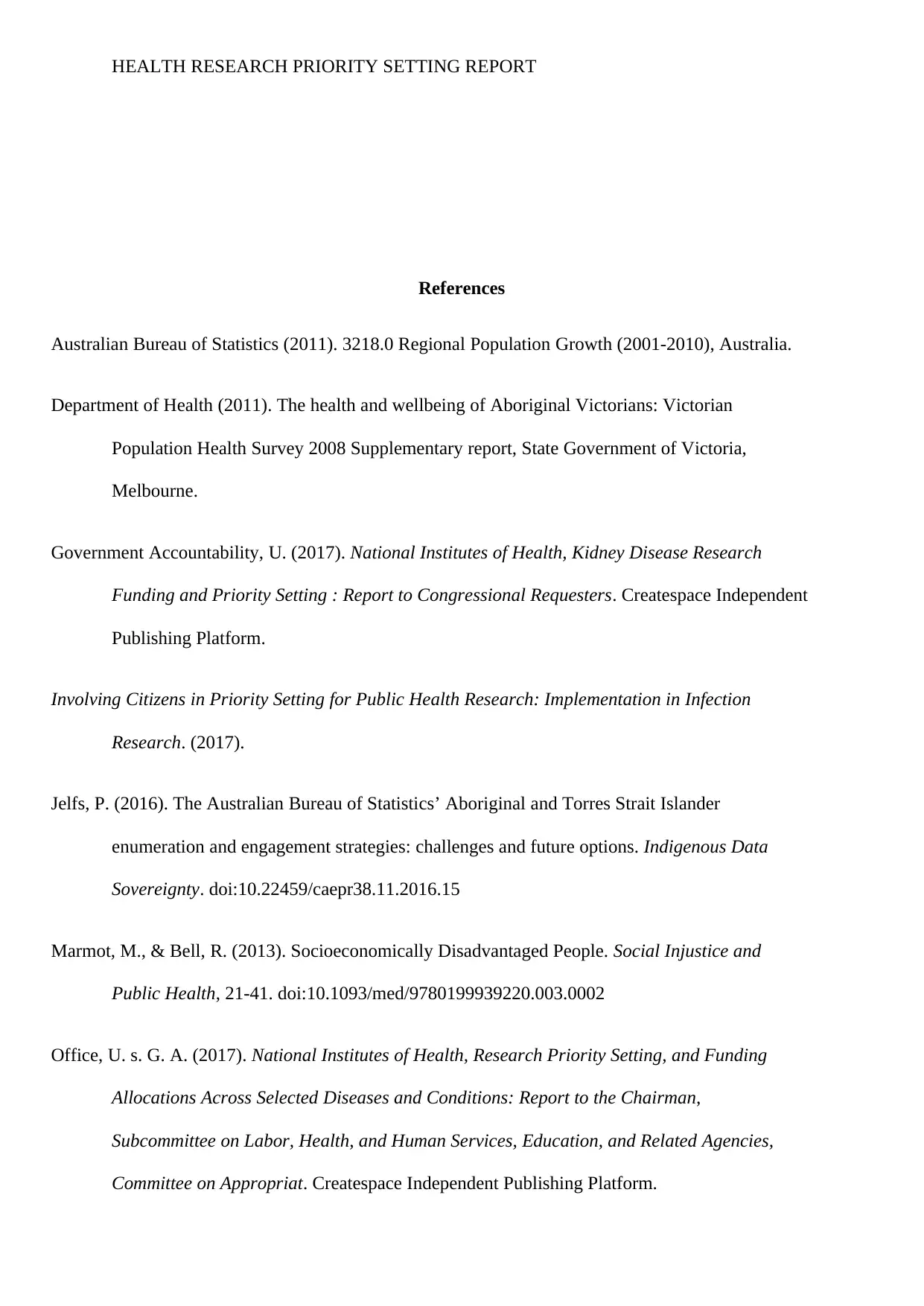
HEALTH RESEARCH PRIORITY SETTING REPORT
References
Australian Bureau of Statistics (2011). 3218.0 Regional Population Growth (2001-2010), Australia.
Department of Health (2011). The health and wellbeing of Aboriginal Victorians: Victorian
Population Health Survey 2008 Supplementary report, State Government of Victoria,
Melbourne.
Government Accountability, U. (2017). National Institutes of Health, Kidney Disease Research
Funding and Priority Setting : Report to Congressional Requesters. Createspace Independent
Publishing Platform.
Involving Citizens in Priority Setting for Public Health Research: Implementation in Infection
Research. (2017).
Jelfs, P. (2016). The Australian Bureau of Statistics’ Aboriginal and Torres Strait Islander
enumeration and engagement strategies: challenges and future options. Indigenous Data
Sovereignty. doi:10.22459/caepr38.11.2016.15
Marmot, M., & Bell, R. (2013). Socioeconomically Disadvantaged People. Social Injustice and
Public Health, 21-41. doi:10.1093/med/9780199939220.003.0002
Office, U. s. G. A. (2017). National Institutes of Health, Research Priority Setting, and Funding
Allocations Across Selected Diseases and Conditions: Report to the Chairman,
Subcommittee on Labor, Health, and Human Services, Education, and Related Agencies,
Committee on Appropriat. Createspace Independent Publishing Platform.
References
Australian Bureau of Statistics (2011). 3218.0 Regional Population Growth (2001-2010), Australia.
Department of Health (2011). The health and wellbeing of Aboriginal Victorians: Victorian
Population Health Survey 2008 Supplementary report, State Government of Victoria,
Melbourne.
Government Accountability, U. (2017). National Institutes of Health, Kidney Disease Research
Funding and Priority Setting : Report to Congressional Requesters. Createspace Independent
Publishing Platform.
Involving Citizens in Priority Setting for Public Health Research: Implementation in Infection
Research. (2017).
Jelfs, P. (2016). The Australian Bureau of Statistics’ Aboriginal and Torres Strait Islander
enumeration and engagement strategies: challenges and future options. Indigenous Data
Sovereignty. doi:10.22459/caepr38.11.2016.15
Marmot, M., & Bell, R. (2013). Socioeconomically Disadvantaged People. Social Injustice and
Public Health, 21-41. doi:10.1093/med/9780199939220.003.0002
Office, U. s. G. A. (2017). National Institutes of Health, Research Priority Setting, and Funding
Allocations Across Selected Diseases and Conditions: Report to the Chairman,
Subcommittee on Labor, Health, and Human Services, Education, and Related Agencies,
Committee on Appropriat. Createspace Independent Publishing Platform.
Paraphrase This Document
Need a fresh take? Get an instant paraphrase of this document with our AI Paraphraser
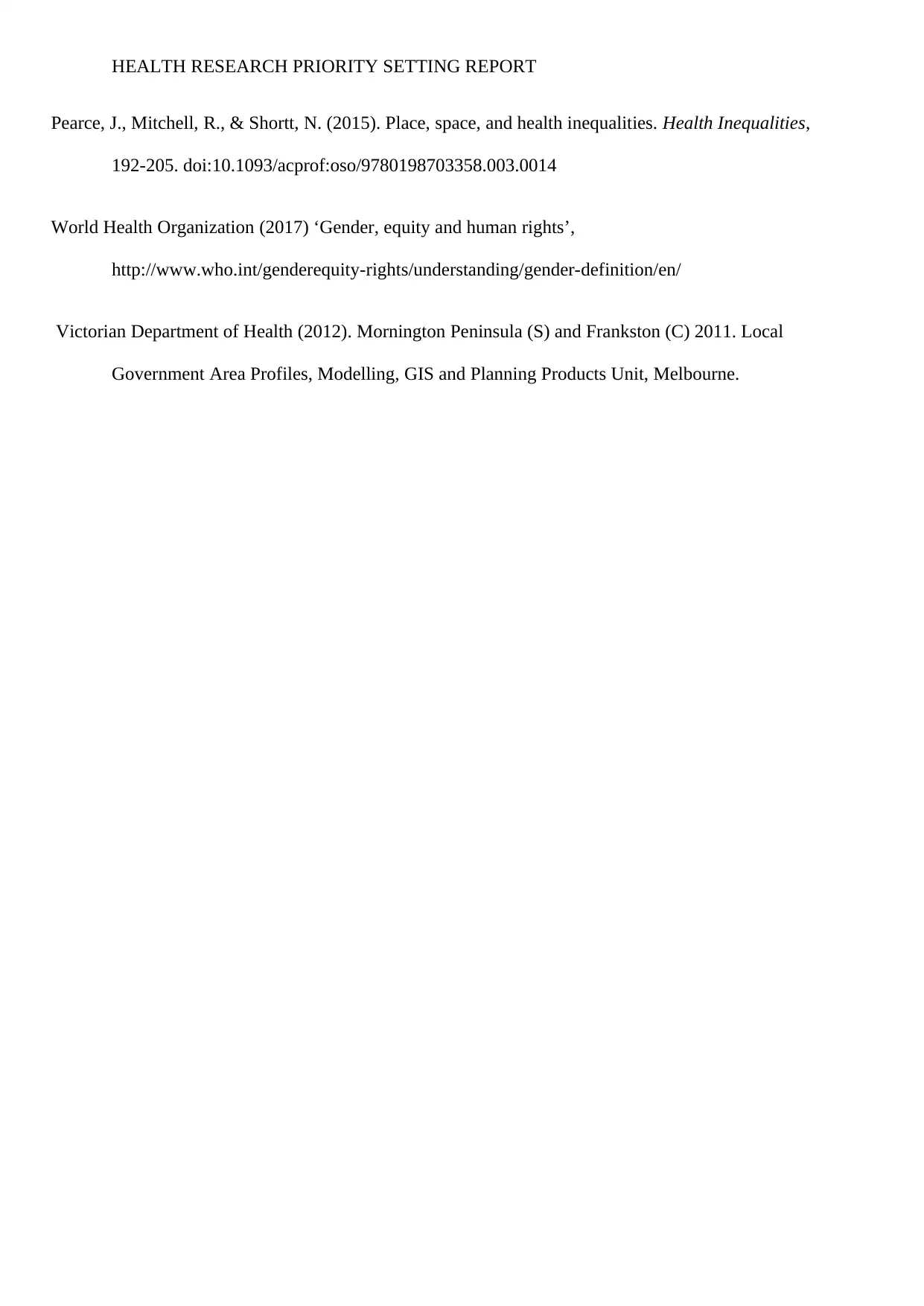
HEALTH RESEARCH PRIORITY SETTING REPORT
Pearce, J., Mitchell, R., & Shortt, N. (2015). Place, space, and health inequalities. Health Inequalities,
192-205. doi:10.1093/acprof:oso/9780198703358.003.0014
World Health Organization (2017) ‘Gender, equity and human rights’,
http://www.who.int/genderequity-rights/understanding/gender-definition/en/
Victorian Department of Health (2012). Mornington Peninsula (S) and Frankston (C) 2011. Local
Government Area Profiles, Modelling, GIS and Planning Products Unit, Melbourne.
Pearce, J., Mitchell, R., & Shortt, N. (2015). Place, space, and health inequalities. Health Inequalities,
192-205. doi:10.1093/acprof:oso/9780198703358.003.0014
World Health Organization (2017) ‘Gender, equity and human rights’,
http://www.who.int/genderequity-rights/understanding/gender-definition/en/
Victorian Department of Health (2012). Mornington Peninsula (S) and Frankston (C) 2011. Local
Government Area Profiles, Modelling, GIS and Planning Products Unit, Melbourne.
1 out of 11
Related Documents
Your All-in-One AI-Powered Toolkit for Academic Success.
+13062052269
info@desklib.com
Available 24*7 on WhatsApp / Email
![[object Object]](/_next/static/media/star-bottom.7253800d.svg)
Unlock your academic potential
Copyright © 2020–2025 A2Z Services. All Rights Reserved. Developed and managed by ZUCOL.





